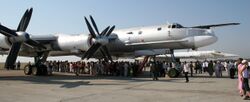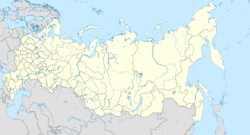قاعدة إنگلز-2 الجوية
| إنگلز-2 | |||||||||
|---|---|---|---|---|---|---|---|---|---|
Энгельс-2 | |||||||||
| إنگلز، أوبلاست ساراتوڤ في روسيا | |||||||||
 | |||||||||
 | |||||||||
| الإحداثيات | 51°28′52″N 046°12′38″E / 51.48111°N 46.21056°E | ||||||||
| النوع | قاعدة جوية | ||||||||
| معلومات الموقع | |||||||||
| المالك | وزارة الدفاع الروسية | ||||||||
| المشغل | القوات الجوية الروسية | ||||||||
| يتحكم فيه | طيران بعيد المدى | ||||||||
| الحالة | جاهزة للعمليات | ||||||||
| تاريخ الموقع | |||||||||
| بُني | 1952 | ||||||||
| بناه | القوات المسلحة السوڤيتية | ||||||||
| قيد الاستخدام | 1954–الحاضر | ||||||||
| المعارك/الحروب | الغزو الروسي لأوكرانيا 2022[1] | ||||||||
| معلومات الحامية | |||||||||
| الحامية | القاذفات الثقيلة من فوج الطيران المئة وأربع وثمانون حرس القاذفات الثقيلة من فوج الطيران المئة والواحد وعشرون | ||||||||
| معلومات مدرج جوي | |||||||||
| المميزات | IATA: none، ICAO: XWSG | ||||||||
| الارتفاع | 37 metres (121 ft) فوق سطح البحر | ||||||||
| |||||||||
قاعدة إنگلز الجوية إنگليزية: Engels Air Force Base (روسية: Энгельс، اسمها الرسمي إنگلز-2) هي قاعدة جوية عسكرية موقعها في روسيا والتي تقع 4 كيلومترات (8.7 ميل) شرق ساراتوڤ. إنگلز هي قاعدة كبرى لعمليات قاذفات القنابل، وهي موقع التشغيل الوحيد لروسيا لقاذفات القنابل الاستراتيجية توپوليف تو-160. تتضمن القاعدة مدرج بطول 3,500-metre (11,500 ft) وحوالي 10 مواقف إعادة تأهيل كبيرة. سُميت القاعدة تيمناً باسم مدينة إنگلز، والتي سُميت بدورها على اسم الفيلسوف الشيوعي، فردريك إنگلز.
القاعدة هي مقر الفوج 121 حرس لطيران القاذفات الثقيلة، الرايات الحمراء لسڤاستوپول بقاذفات توبوليڤ 160M والقاذفات الثقيلة من الفوج 184 لطيران القاذفات الثقيلة لدى توپوليف تييو-95 التابع للفرقة 22 حرس، للقاذفات الثقيلة، الراية الحمراء للدونباس.[2]
وقد هاجمت طائرات من فوج 121 أوكرانيا أثناء الغزو الروسي لأوكرانيا 2022.[3]
التاريخ
في عام 1930، انطلق بناء مدرسة تجريبية عسكرية على بعد 1.5 كيلومتر من مدينة إنگلز، في قطعة أرض شاغرة. وجُهزت المدرسة الرابعة عشرة للطيارين في إنگلز في 15 ديسمبر 1930.[4]وقد ساهم حوالي 10000 شخص في الموقع. في 16 فبراير 1932، استخدمت أول طائرة، پوليكارپوڤ يو-2 الموقع. وبحسب ما ورد أعيدت تسمية المدرسة في نفس اليوم باسم مدرسة إنگلز للطيارين.[4] بحلول عام 1936، كانت مدرسة الطيران العسكري إنگلز واحدة من أفضل مدارس الطيران في البلاد. فقد تدرب الطلاب على پوليكارپوڤ يو-2، پوليكارپوڤ أر-5 وطائرات CSS. قبل الحرب العالمية الثانية قامت المدرسة بتدريب عدة آلاف من الطيارين. قاتل العديد منهم في الحرب الأهلية الإسپانية، وشاركوا في معارك خالخين گول والحرب السوڤيتية الفنلندية (1939-1940). لمشاركتهم في القتال، سُمي سبعة تلاميذ بأبطال الاتحاد السوڤيتي.
في بداية الحرب العالمية الثانية، كانت لدى المدرسة پوليكارپوڤ يو-2، آنت-40، پي-2 في الخدمة، وطائرات أخرى. خلال سنوات الحرب، أرسلت مدرسة إنگلز للطيران إلى الصفوف الأمامية 14 فوج. كان من بينهم ثلاث أفواج نسائية (بما في ذلك ساحرات الليل)، والتي خدمت فيها الرائد مارينا راسكوڤا.[5] 190 pupils of the school were awarded the title of Hero of the Soviet Union for combat exploits.
In the early 1950s, the construction of the new "Engels-2" airport with a concrete runway with a length of 3 km and a width of 100m was begun, and therefore, by September 1954 the Engels school was moved to the city of Tambov. On 15 December 1954, the 201st Heavy Bomber Aviation Division was established, comprising the 79th, 1096th and 1230th Heavy Bomber Aviation Regiments (TBAPs). The personnel of the regiments was assembled by choosing the best specialists of the Long Range Aviation, graduates of military schools and academies. Also in 1954, the Engels area was closed off from Western ground observation.[6]
The first Myasishchev M-4 bombers arrived in Engels on 28 February 1955. In May 1957, the first modernised 3M bomber arrived. In 1957, the 79th Heavy Bomber Aviation Regiment was transferred to Ukrainka and was transferred to the 73rd Heavy Bomber Aviation Division. Gradually the M-4 and 3M bombers were converted into aerial refuelling tankers. Air refueling significantly increased the range of the bombers, which expanded their capacity. Around 1960, the 1230th Heavy Bomber Aviation Regiment was renamed the 1230th Aviation Regiment Air Refueling.[7] The 3M bombers were part of Long Range Aviation until 1985, and then were destroyed in accordance with the agreement on the reduction of offensive weapons. The 3MS-II and 3MN-II, converted into tankers, were in service for much longer – up to the end of 1993 and before being replaced by the more advanced Il-78.
The base was to have received the first production Tu-160 in 1987, but it went to Priluki, whose units had Tupolev Tu-22M experience. The first three Tu-160s not at Pryluky were incorporated into the 1096th Heavy Bomber Aviation Regiment in 1992.[8] By 1994 Engels had five Tu-160 bombers in operation, and that same year the 1096th Heavy Bomber Aviation Regiment was redesignated the 121st Heavy Bomber Aviation Regiment, adopting its colours and traditions. In 1998 the START I treaty exchange of information showed it had 20 operational Tupolev Tu-95 bombers and six Tu-160 bombers, all with cruise missile capability.
From 1999 to 2001 the base received eight Tu-160s from Ukraine paid for by gas price reductions. The last two arrived on 21 February 2001.[9] The 184th Guards Heavy Bomber Aviation Regiment was reformed at the base on 1 September 2000, drawing on Tu-95MS aircraft transferred from Mozdok.[10] By 2007 the base had 14 Tu-160s, 20 Tu-95s and an unknown number of Tu-22Ms.
Construction of a new runway parallel to the existing one was completed in 2015 in conjunction with a supporting network of taxiways, communications, electrical and meteorological systems. The new runway will be able to handle all Russian Air Force aircraft.[11]
في 5 ديسمبر 2022، an explosion caused by a Ukrainian drone attack damaged two Tu-95s.[12][13] According to Russian Ministry of Defence, Ukraine attempted to strike Russia's long-range aviation bombers stationed at the base with Soviet-made jet drones. Russia claims the drones were intercepted by air defence systems at low altitude.[14]
الطائرات
اعتبارا من 2007[تحديث], the base had:
- 14 Tu-160s (121st Guards Heavy Bomber Aviation Regiment)
- 20 Tu-95s (184th Heavy Bomber Aviation Regiment)
- Unknown number of Tu-22M-3s (6950th Aviation Base)
- 1 Ilyushin Il-62
The 22nd Guards Heavy Bomber Aviation Division of the 37th Air Army controlled operations at the base up until the Air Force reorganisation of 2009–10.[15] In 2015/16, the division was reformed within the Russian Aerospace Force's Long-Range Aviation branch and based at Engels.[16]
المتحف
At the Engels airbase is the Long-Range Aviation Museum. This unique open-air museum was opened on September 6, 2000. It was visited[when?] by more than 5,000 people in a year.[بحاجة لمصدر]
The museum displays:
- airplanes: Ilyushin Il-62, Myasishchev M-4-3MS-2, Antonov An-2, Antonov An-12, Antonov An-24, Tupolev Tu-95, Tupolev Tu-22, Tupolev Tu-134, Aero L-29 Delfín, Aero L-39 Albatros, Tupolev Tu-22M3;
- cruise missiles: Kh-55, Kh-22НА, Kh-20М, KSR-2UD;
- bombs: FAB-9000 M, FAB-5000 M, FAB-3000 M, FAB-1500 M, FAB-500 M, FAB-250 M, FAB-250 TS, SAB-250 T, OFAB-250, NOSAB-100TK, DOSAB-100 TC;
- historically valuable items: attributes of the Long-Range Aviation of Russia, commemorative photographs, fragments of rare aircraft.
The museum also contains books for reviews, the records of which were left by the presidents Boris Yeltsin and Vladimir Putin. A room was built where models of airplanes are presented, stands illustrating the history of long-range aviation, aircraft dashboards, and aircraft armament.[البحث الأصلي؟]
The director of the museum is reserve major Sergei Alexandrovich Voronov.[بحاجة لمصدر]
المراجع
- ^ AirForces Monthly. Stamford, Lincolnshire, England: Key Publishing Ltd. April 2022. p. 16.
- ^ "Engels-2 (UWSG)". Scramble.nl. Retrieved 16 November 2022.
- ^ AirForces Monthly. Stamford, Lincolnshire, England: Key Publishing Ltd. December 2022. p. 30.
- ^ أ ب "Tambov Higher Military Aviation School of Pilots". ww2.dk. Retrieved 2016-10-27.
- ^ "Боевой путь полка".
- ^ (U) HEAVY BOMBER TARGETS, Central Intelligence Agency, 21 May 1958.
- ^ Butuwski 2004, 84.
- ^ Butuwski 2004
- ^ Butowski, Piotr. "Russia's Strategic Bomber Force". Combat Aircraft. 4 (6): 552–565.
- ^ Butowski 2004, 82.
- ^ "Главнокомандующий ВВС проверил ход масштабной реконструкции аэродрома Энгельс. "The commander-in-chief of the Russian Air Force inspected the progress of large-scale reconstruction of Engels airfield"". Ministry of Defence of the Russian Federation (press release). 5 March 2015. Retrieved 26 July 2017.
- ^ "Ukraine destroys two Russian nuclear bombers in airport bombings". 5 December 2022. Retrieved 5 December 2022.
- ^ "Explosions rock two Russian airbases far from Ukraine frontline". 5 December 2022. Retrieved 5 December 2022.
- ^ "US commercial satellites surveyed Russia's Engels airstrip ahead of Kiev's strike attempt". tass.com. 5 December 2022.
- ^ Piotr Butuwski, 'Air Power Analysis: Russian Federation Part 2', International Air Power Review, Summer 2004, 80–81.
- ^ Nicholas Myers, The Russian Aerospace Force p. 98 https://wsb.edu.pl/container/Wydawnictwo/Security%20Forum/1-2018/8.pdf
ببليوگرافيا
- Healey, John K. (January–February 2004). "Retired Warriors: 'Cold War' Bomber Legacy". Air Enthusiast. No. 109. pp. 75–79. ISSN 0143-5450.
وصلات خارجية
- GlobalSecurity.org, Engel's, accessed December 2012.
- "Report on Bomber Elimination at Engels AFB", FBIS Daily Report FBIS-SOV-95-136, 5 July 1995
- Pages using gadget WikiMiniAtlas
- Short description is different from Wikidata
- Coordinates on Wikidata
- Articles containing إنگليزية-language text
- Pages using Lang-xx templates
- Articles containing روسية-language text
- مقالات فيها عبارات متقادمة منذ 2007
- جميع المقالات التي فيها عبارات متقادمة
- Vague or ambiguous time from December 2022
- مقالات ذات عبارات بحاجة لمصادر
- All articles that may contain original research
- Articles that may contain original research from December 2022
- Soviet Long Range Aviation bases
- Soviet Air Defence Force bases
- Russian Air Force bases
- Buildings and structures in Saratov Oblast


